#eagle egg hatching
Text
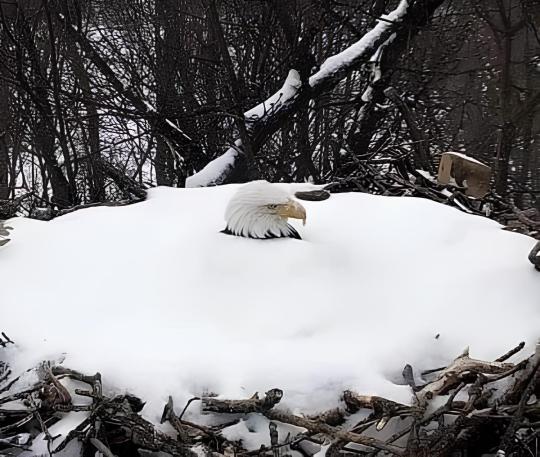
A bald eagle in Shepherdstown, West Virginia, is proving just how far moms will go to keep their babies safe. Even being buried up to her head in the snow won’t stop this eagle mom, known as Bella, from keeping her eggs warm. Bella and her mate, Smitty, have returned to their nest 100 feet up in a large sycamore tree near the Potomac River every year since 2011 to raise their chicks.
#hatching eggs#eagle moms#bald eagle#nature#protecting babies#brooding eagle#eagle egg hatching#hatching eggs in snow#wow#buried to the neck#brave animal moms#<3#raising eagle chicks
15 notes
·
View notes
Photo
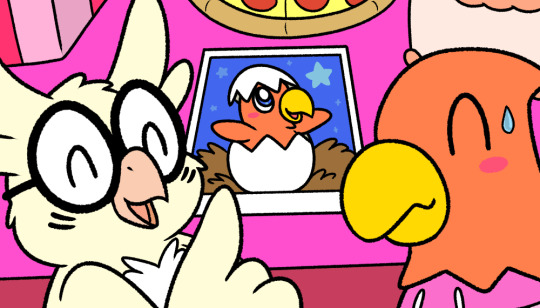
Hehe, today is Alistar's birthday! Or rather, hatch day for us birdies. Looks like somehow their hatchling pictures came out, so we all get to see how cute they were as a baby eagle egg. D'awwww~ Happy bird-day buddy! nvn
Posted using PostyBirb
4 notes
·
View notes
Text
best celebrity couple
youtube
#jackie and shadow#big bear valley eagles#bald eagle#bird#animal#video#i seriously adore these two and so desperately hope their eggs hatch successfully 🤞🤞🤞🤞🤞🤞#❤️❤️❤️❤️❤️❤️❤️🤗🦅🥰
1 note
·
View note
Photo




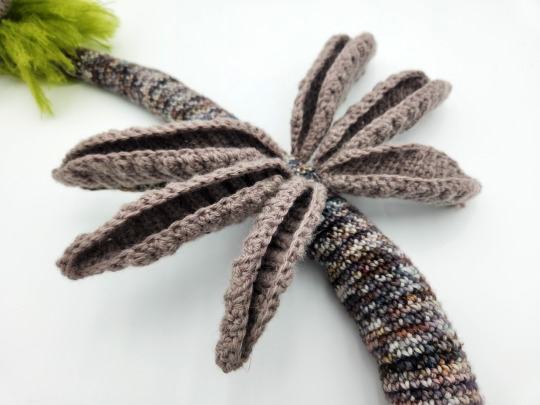

The woodland amphithere (Amphitheris silva), also known as the fairy dragon or the beech wyrm, is a small draconoid endemic to the temperate broadleaf forests of the Sunken Continent. Vestigial wings aid in thermoregulation and can be freely contracted and expanded. The shapes of these wings have evolved to resemble the leaves of beech, hornbeam, and other marcescent trees that are the favored hunting territories of woodland amphitheres. Fur-like moss growth on its head and tail enable it to supplement its primarily insectivorous diet with photosynthetic energy.
Previous | Next
(Extended species description under readmore.)
The woodland amphithere (Amphitheris silva), also known as the fairy dragon or the beech wyrm, is a small draconoid endemic to the broadleaf forests of the Sunken Continent.
Vestigial wings aid in both gliding and thermoregulation. Each wing can move independently of one another, and their membranes can be freely contracted and expanded (see last image/GIF in gallery). The shapes of these wings have evolved to resemble the leaves of beech, hornbeam, and other marcescent trees that are the favored hunting territories of woodland amphitheres. Whole covens have been observed sunning themselves on tree branches in autumn and winter.
Fur-like moss growth on its head and tail enable it to supplement its primarily insectivorous diet with photosynthetic energy. This adaptation along with their unique wing structure allows them to forego hibernation altogether in more temperate regions.
Two pairs of eyes make these creatures adept hunters. The rostral pair are used to observe shape and color while the caudal pair specialize in tracking the movement of their prey.
Like many extant members of the amphitherid and other draconoid families, the woodland amphithere possesses relays, growths on the head which house complex electroreceptors. Relays in this species have evolved as rigid, antler-like structures. The exact purpose of these relays is unknown, but it is hypothesized that they may be involved in communication between members of a given coven.
Woodland amphitheres are semisocial and congregate in single-generation groups known as a coven or a flight. Covens are typically made up of six to ten individuals, although covens as large as two dozen have been observed. While they do not exhibit the same coordinated hunting prowess of other amphithere species, they are still remarkably sociable and have been observed to groom and to sing to one another.
Eggs are laid in communal nests in small ponds in early spring, and the brood is left to fend for itself by the parent coven shortly after hatching. The fry begin life as tadpole-like creatures with their wings and relays becoming fully developed by midsummer. The brood may linger for up to a year near its birth pond before leaving in search of new hunting territory.
Birds of prey, including eagles, owls, and lesser rocs, are typical predators of woodland amphitheres. Its primary defense is its own coven, which will swarm upon and harass the predator to drive it away. Larger covens have even been known to kill and subsequently feed on their would-be attackers, especially during the nesting season.
---
First entry in what will be a small series of original dragon amigurumi patterns following a general amphithere body plan (basically all wing and no leggies lol).
My personal challenge for each of these is that I cannot directly reference patterns from other creators. This is to (1) force me to figure out how to work up complex shapes and (2) so that I can avoid copyright infringement if I ever decide to sell these patterns a later date. Which was why a good portion of the time for this entry was working out the shapes of the leaves for the wings, haha.
#dragon#amigurumi#fantasy#crochetblr#speculative biology#beasts of the sunken continent#xen makes frens#her name is beech and she compels you to boop the snoot
4K notes
·
View notes
Text
Part 4 Trolls Headcanons/ Theories/ Thoughts/ Ideas
Part1 Part2 Part3 Part5 Part6 Part7 Part8 Part9 Part10
Bruce - theorizes that his daughter LaBreezy will be the one to take over the restaurant.
Bruce - tries developing and inventing his own recipes, Brandy has to remind him that not everyone can handle as much sugar as a Troll can. He reels it back a bit.
Bruce - makes specific food for different reasons. E.g. makes bread when he's angry so he can take it out on the dough, makes lasagnas so he can use the leftovers as an excuse to visit someone, makes spicy dishes when he wants revenge.
John Dory - has been arrested before, he changes the reason everytime someone asks.
John Dory - occasionally uses 'chewing tobacco' (which honestly in the Trolls-verse would be some kinda chewing gum 😂)
John Dory - serial flirt (very bad at it, he thinks he's great at it)
John Dory - does weird stuff because of his isolation e.g. will eat what's left over on the plates when Bruce's customers leave, will ask when the baby's due but they're just overweight, will go into detail about gutting a fish in front of Trollings.
John Dory - can open a wine/champagne bottle with his machete and light a match with his teeth
Clay - occasionally tutors math to Trollings.
Clay - has a decent sized nest egg
Clay - graduated highschool early
Clay - has business cards stored in his hair
Clay - knows how to tie different knots for neckties.
Clay - can spin a pen around his fingers
Clay - is thinking of getting his own critter transportation
Floyd - was 100% sure he was going to die in the bottle. He now has a new outlook on life after being given a second chance.
Floyd - wants a long term relationship but is afraid of getting attached and being used.
Floyd - practices advanced yoga
Floyd - has developed claustrophobia
Floyd - released one solo album, one limited run, it was mentioned he is a former member Brozone on the cover to boost sales. It was a flop. This crushed Floyd.
Branch - toying with the idea of building plans for a Pop Village Castle. (Secretly a fortress)
Viva - biggest Broppy shipper. Already has their wedding planned in her head.
Viva - adrenaline junkie
Viva - no sense of personal space
Tiny Diamond - checks on Branch and Poppy's egg daily asking if his new BFFL is here yet.
Pop Trolls - King Peppy invented all these bizarre holidays when they were trapped in the Troll tree to keep hope alive and to boost morale.
Putt-Putt Trolls - all delayed having Trollings worrying for their future safety. The very few eggs that hatched are hidden and protected by the whole tribe. (Putt-Putt baby names: Birdie, Par, Ace, Caddie, Fore, Eagle, Divot, Links, Scramble) Clay and Viva were present for every one of them hatching.
Rhonda - locks JD outside when she's annoyed with him. "Who needs you, I wanted to sleep on this rock anyway!"
#dreamworks trolls#trolls#trolls band together#trolls floyd#trolls clay#trolls john dory#trolls bruce#trolls viva#trolls branch#trolls poppy#broppy
166 notes
·
View notes
Note
Dragons work a lot like eagles.
Nesting pairs often lay two eggs, and the first to hatch gets doted on whilst the other is neglected and often abandoned. It's just a fact of Dragon society. There's only so much resources in the End, after all.
That's why everyone gets weird look on their faces when Grian and Pearl introduce themselves as twins.
(you could go somewhere with this, but brain stopped functioning past heehoo character concept)
.
197 notes
·
View notes
Text

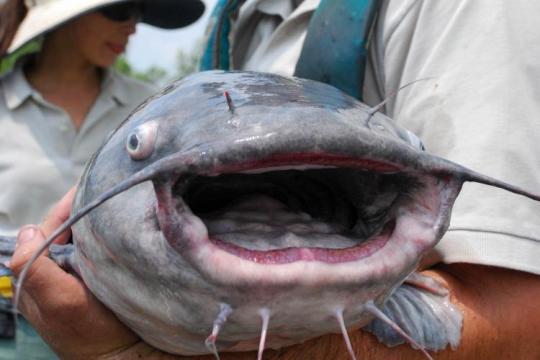
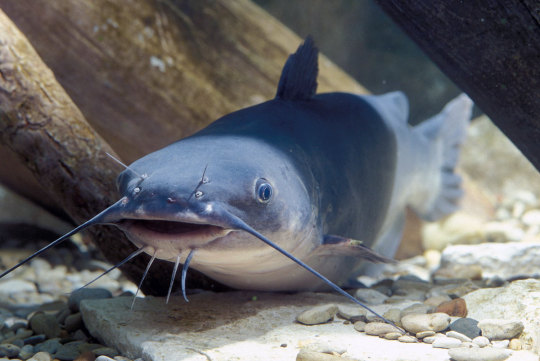
The Beautiful Blue Catfish
Blue catfish (Ictalurus furcatus) are members of the bullhead catfish family, native to the drainages of the Mississippi, Missouri, and Ohio river basins and the Gulf of Mexico. Because of their popularity as game fish, this species has also been introduced to freshwater systems throughout North and South America, and is considered invasive in these areas.
Like many catfish, I. furcatus is a bottom dweller. They can often be found near complex structures such as rocky outcroppings, fallen trees, or sunken structures that provide both food and shelter. The blue catfish is an opportunistic predator, consuming any fish or aquatic invertebrates it can find, as well as eggs, small amphibians, and injured or recently deceased animals. Adult I. furcatus are seldom prey for other species due to their size, but hatchlings and juveniles are often food for cormorants, willets, osprey, pelicans, and bald eagles. To deter predators, this species has serrated barbs along their dorsal and pectoral fins, each laced with a particularly painful toxin.
Though they can be difficult prey for other animals, the blue catfish is a popular target for fishermen, and for good reason; they're the largest species of catfish in North America. Adults can easily reach a length of 65 in (170 cm) and a weight of 165 lb (75 kg). As indicated by their name, most individuals are grey or blue, with a lighter underbelly. This species also lacks scales, a common characteristic of catfish, and the face is framed by long whisker-like barbels that help it detect nearby food.
While generally solitary, blue catfish aren't territorial, and tend to ignore each other until the mating season. Reproduction begins in April and continues until June, during which time males attract a female by building a nest and releasing attractive pheromones. Once a female has selected a male, she lays between 4,000-8,000 eggs per kilogram of bodyweight in his nest (i.e. if the female weighs 2 kg, she may lay between 8,000-16,000 eggs). The male then disperses sperm over the eggs. Following fertilization, the male chases away the female and guards the nest for about a week, at which time the eggs hatch. The hatchlings, also known as fry, stay close together in schools for several weeks before growing large enough to disperse. It will take them a further 5 years for them to reach maturity; on average individuals live about 10 years, but can live as long as 25.
Conservation status: The blue catfish is considered Least Concern by the IUCN. Within its native range, populations face minor threats from dams and droughts. Where it has been introduced, the species is considered invasive due to its voracious appetite.
If you like what I do, consider leaving a tip or buying me a ko-fi!
Photos
Missouri Department of Conservation
NOAA
Earl Nottingham
#blue catfish#Siluriformes#Ictaluridae#ictalurids#catfish#ray finned fish#bony fish#fish#freshwater fauna#freshwater fish#rivers#river fish#lakes#lake fish#north america#southern north america
218 notes
·
View notes
Text
Birdwomen
Family: Harpyidae
Birdwomen are the most common of magical creatures, appearing on every continent except for Antarctica*. Opportunistic omnivores, birdwomen take the form of massive carrion birds, typically corvids, vultures, condors and eagles, with the heads of women. They appear to be exclusively female; however, some species such as the Mediterranean harpy (Harpia strophades) do pair up during the mating season, with members impressing prospective partners by inflating a pair of gular sacks at the base of the throat similar to the behaviour of frigatebirds (family Fregatidae) and the greater sage-grouse (Centrocercus urophasianus).
The magic of most species of birdwomen are affiliated with storms and disease. The alkonost (Harpia bilibinae) lays its eggs in the sea, and their hatching causes thunderstorms to form, while the droppings of the Mediterranean harpy immediately befoul food.
While most species are reluctant to directly attack humans, birdwomen have no qualms in consuming carrion. Multiple cultures report birdwomen as constant companions to sites of battle and bloodshed. Nordic myths of Valkyries spiriting away the dead are almost certainly inspired by the sight of Scandinavian species of birdwomen feasting on the bodies of the slain after battle, possibly the crested harpy (Valkyria cristatus), nicknamed by professional harpiers as the "Thor's falcon."
The North American birdwoman (Harpia canadensis) is the largest known species of birdwoman, with species standing between five and six feet tall, with respective wingspans of 12 to 15 feet wide. Easily identified by their black, iridescent plumage, North American birdwomen exhibit an intelligent, often playful and curious personality. While native to western and central Canada and the northwestern United States, one birdwoman was sighted in Point Pleasant, West Virginia through the late 1960s; following the 1967 Silver Bridge collapse, one harpier reported seeing this same birdwoman consuming the bodies of two disappeared travellers who had washed up downriver.
*Sightings of the "penguinwomen" of Antarctica are unsubstantiated and should not be counted as fact.
#harpies#unreality#narrativia#i have spiderwick on the brain and this happened#valkyries#norse mythology#mothman#cryptids
81 notes
·
View notes
Note
all this dad!Aemond talk got me thinking - how would he answer the dreaded "how are babies made" question? 🤣 Mom and Dad keep having more and more babies, the older ones are sure to ask this sooner or later
hahaha omg this is a wonderful ask, I just adore how we as an Aemond fandom have absolutely fallen in love with the idea of him as a father. It makes me so happy and breaks my heart at the same time!
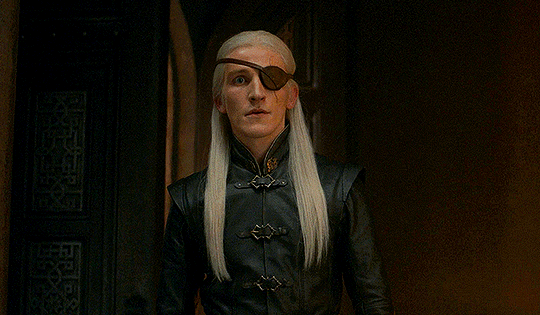
"Kepa, how are babies made?"
Aemond closes his eye briefly, taking a deep breath in through his nose. He knew this question was coming; however, he had held hope that it would be his wife who was posed this question by their six-year-old daughter.
He opened his eye to find her cherub face staring earnestly back at him, her wide lilac eyes reflecting the light from the fire as she gripped tiny fingers around his pant leg. "You and muña talk a lot about 'making another baby'."
So she'd overheard that.
"Normally..." Aemond began slowly, choosing his words carefully as his daughter clung to each one with ardent interest. "A giant eagle brings the parents their baby when they want one." He tousled his daughter's curly silver hair affectionately, making her scrunch her small nose at him. "You are special, Issa byka zaldrīzes. My little dragon. You were hatched within a dragon egg and flown to us by Vhagar." He smiled at her awed expression.
His daughter took a moment to digest what he'd told her a soft "wow" escaping her in a whisper.
At this moment Aemond's wife entered the room, accepting the welcoming hug of their daughter as the little one ran into her arms. She straightened, looking questioningly at Aemond's face.
"Off to bed with you, my love." His wife ushered their daughter from the room, turning back to him once she was out of earshot. "What has you looking like you just fought off a wild boar?"
"Something much worse than that. She asked me where babies come from." Aemond ran a weary hand over his face. "Apparently we were overheard talking of having another child."
"I see." She tried to cover a laugh, coughing unconvincingly into her hand.
Aemond shook his head, smiling despite himself. "Laugh now, my ember. However you will be the one answering her when she asks again in ten years."
#aemond drabble#dad aemond#I think he did alright#aemond#aemond stannies#pro aemond targaryen#aemond imagine#aemond fluff#aemond targaryen#aemond x you#aemond x reader#aemond x wife#aemond x fem!reader#aemond x oc#aemond x y/n#aemond targaryen drabble#hotd drabbles#aemond one eye#hotd aemond#prince aemond#aemond fanfiction#aemond fic#aemond headcanons#aemond blurb
634 notes
·
View notes
Text

Jackie and Shadow, a pair of bald eagles in San Bernardino county(specifically Big Bear) just had THREE eggs which has people absolutely rocked right now
People are egg-erly(heh) awaiting the hatching of the eaglets and meanwhile Jackie and Shadow are absolutely adorable. Shadow is constantly trying to get Jackie to let him have a turn to incubate the eggs, going as far as to use food to lure her off of them. Jackie is older and bigger of the two so she’s usually the one doing the sitting and she’ll nibble at Shadow if he bothers her too much but otherwise they’re very lovey and affectionate
Guys guys these eagles have me crying fr
Anyways if you want to watch Jackie and Shadow, or be there for the egg hatching, here’s a link to the webcam for y’all. The babies were laid in late January and are set to hatch within two weeks(any day now!!)
In the meantime I hope you’ll like this drawing I made of California and San Bernardino being so proud of their eagles
#wttt#welcome to the table#ben brainard#wttt california#wttt san bernardino#wttt oc#original character(s)
48 notes
·
View notes
Text
Pontalo AU Masterlist
LightWings full information!
i did not know how to describe how their names are chosen lmfao, also this took a million years to make

LightWings are one of the seven tribes inhabiting Pontalo. However, they have been nearly wiped out from constant pressure from the BloodWings, having most of their territory taken. Most LightWings have either fled, gone into hiding, or been killed. They are pacifists and believe in peace instead of fighting. Their current queen is Peacekeeper.
Description:
LightWings are bird-like dragons, with feathers running down from their foreheads to around their tail, behind their legs, and below their snout. They have sharp, bird-like talons, and feathered wings that reach a large wingspan. They also have hollow bones and are lightweight. LightWings are slightly shorter than the other tribes, other than the HydroWings, have slim bodies, and come in light, pastel colors. However, their wings are pure white and their other feathers can come in various bright colors. These have been described to attract other LightWings. They have blue or yellow eyes. LightWings also have dapples of luminescent scales running along their necks and legs, and they have curved horns.
LightWing eggs are bright white, and slightly glow when they are hatching.
Diet:
They eat a variety of fruits, as well as hawks, eagles, goats, squirrels, wild pigs, deer, cougars, rabbits, and other birds of prey. They can also somewhat get energy from the sun, which was more potent in ancient times. This was passed down onto their relatives, the SunWings and ShapeWings. However, they have developed to not rely as much on the sun, instead developing an omnivorous diet.
Abilities:
LightWings have light elemental powers, specifically able to shoot light beams out of their mouths as well as manipulate light waves, creating lasers. These are also energy-based, and they take a long time to recharge. LightWings also have healing powers too, which are amplified by herbs they gather and trade from the forest. However, with the threat of the BloodWings, their healing powers have weakened significantly.
Animus magic:
There have been traces of animus LightWings in the past, like the great Lightbringer, but only a few have animus blood now. One, yet unknown, animus is Hopebringer.
Society:
LightWings are considered artistic and creative, able to create songs, dances, which attract partners, and writings. Typical jobs include being a(n) writer, musician, ambassador, guard, dragonet caretaker, healer, and many other jobs.
Ancient era:
LightWings is the most ancient Pontalonian tribe, having populated the whole continent in separate colonies, and are related to the SunWings, HydroWings, MoonWings, and ShapeWings. The colonies were different in many ways, slowly evolving into those four tribes by partnering with other dragon species that would visit Pontalo. They were carefree and good-natured, trading with other colonies and traveling among themselves.
Lightbringer era:
Lightbringer was a powerful animus LightWing that lived during ancient Pontalo. She was known as the protector of the LightWings, as the evolved tribes slowly began to separate, causing conflict and disagreement over territory. The original LightWing colonies were then brought together by Lightbringer, and slowly, she brought peace to Pontalo. Lightbringer is revered as a symbol of greatness by the LightWings, almost like Clearsight to the HiveWings. She first introduced the idea of pacifism and peace to the LightWings.
Modern era:
LightWings were welcoming and trusting to the BloodWings when they arrived, which is leading to their downfall as their attacks continue to pressure them using the element of surprise. Over 75% of the tribe has been killed, and some flee to the unknown land Paradox landed in, going into the protection of the Light Tribe, some hiding, and some trying to reason with the BloodWings. They have become paranoid as a result of the amount of BloodWing ambushes.
Names:
LightWing names are meant to give a sense of hope or good will. They can also be light-themed or inspired by their powers.
Trivia:
LightWings originally did not have that many feathers, they were only dragons with feathered wings.
Paradox believed the LightWings were extinct, until Hopebringer showed up at her school.
#blizz’s nonsense#blizz's art#Pontalo!!!#wings of fire#wof#wings of fire au#wof au#wings of fire art#wof art#im tired asf im taking another break before writing the lightningwing stuff#also i didnt proofread this sooo uhhh
20 notes
·
View notes
Text

Concerns Grow Over Eagle Eggs in Big Bear
[March 7, 2024, Big Bear, CA] The bald eagle couple, Jackie and Shadow, have been caring for their eggs, which generally have a 35-day incubation period, since they were laid in late January.
“For the first egg we’re just past 38 days …so that first egg is probably not viable,” eagle expert Sandy Steers said, "but the other two eggs are still within the window of possibility." They could hatch any time over the next several days.
Check in with Jackie, Shadow and their growing family anytime, on the live Big Bear camera.
#nature#eagles#Big Bear#animals#aesthetic#news#wildlife#mountains#forest#birds#photography#landscape#vacation#landscapes#documentary#life#California#beauty-funny-trippy#nature photography#birding#bird watching#Jackie#Shadow#bald eagles
29 notes
·
View notes
Text
🍷The Heir of Evil🐉 AU fans have decided, and...
🍷The Heir of Evil🐉 AU Reader will be an IceWing!!
I have a few headcanons for them, and a a bit of backstory and lore planned, too😊 Let's dive in:
• ❄IceWing!🍷Heir of Evil!🐉 Reader is the grandchild or great-grandchild to the wicked IceWing queen, specifically the one who put the tribe into multiple wars and skirmishes and tried to take over the dragon world. Reader isn't like her (they're not an irredeemable monster who hurts others for fun)
• Heir! Reader wears jewelry that is mostly silver or black, but loves any sort of colorful gemstones or charms...
• Heir! Reader only wears the pieces of jewelry that are necessary; they don't want to waste the tribe's treasure on frivolous items, and if the jewelry appeals to other tribes, then it might make Reader and the IceWings seem more appealing, like they're dragons, too...
• Heir! Reader is good with algebra, dragon biology, and creative writing...
• Heir! Reader is torn between what the two sides of their kingdom wants: to stay unscheming and try to foster peace, hoping other tribes will leave them alone and not hurt them further... or to amass enough power and treasure that they can wage a war against the other tribes, or at least the IceWing hybrids who some view as traitors...
• Heir! Reader's necklace they were told to never take off is enchanted, but they don't know that. The necklace hides something about them, which is why their vanished/dead parent gave it to them...
• Heir! Reader has had to stop a coup for their throne/title at age four (about 12 year old in WoF dragon years), which led to them earning the respect of the remaining advisors and generals of their late parent/late family, as well as the respect of the few nobles left and the different IceWing villages...
• Heir! Reader's hatching day is a mystery, as no one ever saw their egg, nor them, when they were first hatched, save for their deceased parent and a late ally of their's...
• Heir! Reader has an army of pet foxes, all of which are (diet) platonic yandere for them (they're all so cute and cuddly and fluffy-!)
• Heir! Reader, unlike most IceWings, enjoys trying cooked meats and exotic dishes from other tribes and kingdoms...
• Heir! Reader prefers to sleep with a fur blanket, not because they're cold (they're an IceWing), but because they like the soft fur and fuzzy texture...
• Heir! Reader is an aromantic-asexual...
• Heir! Reader enjoys traditonal IceWing foods such as fresh salmon with lemon juice, thinly-sliced caribou strips, puffin and moss salad, kalimari (squid), bear jerkey, ox ribs seasoned lightly with moss, seal meat marinated in ginger/lemon/honey, as well as ice cream, frozen berry slush, and lemon-flavored shaved ice...
• Heir! Reader likes traditional dishes from other kingdoms such as: MudWing's Diamond Delta Gumbo, SandWing's Cinnamon Milk and Roasted Lizard Kebabs, SkyWing's Charred+Barbecued Eagle Wings, SeaWing's Thousand Scales Thousand Fish Sushi, RainWing's Mango-Orange Juice, NightWing's Smoked Boarchops, HiveWing's Honey-roasted Shrimp, SilkWing's Loaded Baked and Sweet Potatoes, and LeafWing's Planter's Pie...
• Heir! Reader sometimes wears a small, spiked tailband on the end of their tail, nestled above where their spikes are...
• Heir! Reader enjoys sunrises, and writes new poems and hymns for their tribe to sing at their Gifts of the Ice Dragon Festival...
• Heir! Reader enjoys old literature, especially comedies...
(I will make another post about Heir! Reader facts, but dealing with IceWing culture)
(I wonder what their name could/should/would be?)
#honeycomb thoughts#platonic yandere marvel#yandere platonic marvel#platonic yandere marvel x reader#platonic yandere xmen#yandere x-men#platonic yandere#platonic yandere x reader#platonic yandere xmen evolution#🐉wings of fire au#🍷the heir of evil🐉 au#platonic yandere xmen evolution au#yandere platonic xmen
29 notes
·
View notes
Text


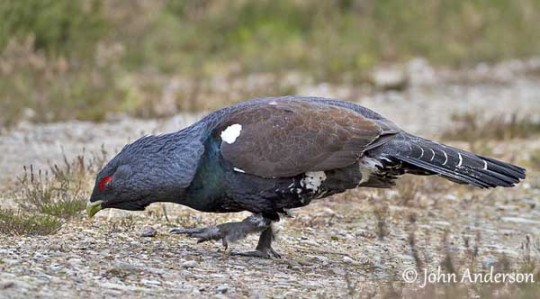




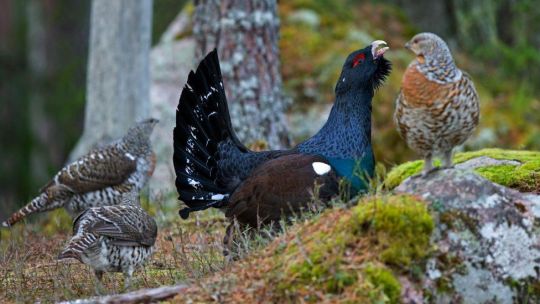


The western capercaillie (Tetrao urogallus), also known as the Eurasian capercaillie, wood grouse, heather cock, cock-of-the-woods, or simply capercaillie is a species in the grouse family which is endemic to the taiga and boreal forest of Northern Eurasia, from Scotland in the west to Russia in the east. They are typically diurnal ground dwelling birds which while capable of flight, are fairly clumsy in the air due to there short rounded wings. While taking off they produce a sudden thundering noise that deters predators. At night they rest in the horizontal branches of tree stands or within thick ground cover such as bushes and sedges, emerging during the day to feed upon seeds, buds, leaves, berries, insects, grasses, and conifer needles. Capercaillies are themselves eaten by wolves, lynx, foxes, eagles, martens, bears, boar, goshawks, and owls. With females reaching around 21- 25 inches (54- 64 cms) long & 3.5 to 5.8lbs (1.5 to 2.5kg) in weight while the male can reach 29 to 40 inches (74 -100cms) long and 9lbs to upwards of 15lbs (4 to 7kg) in weight, the western capercaillie is one of the most size sexually dimorphic living bird species, only exceeded by the larger types of bustards and a select few members of the pheasant family. The females upper parts are brown with black and silver barring; on the underside they are more light and buffish yellow. While the males are dark grey to dark brown, with the breast feathers being dark metallic green. The belly and undertail coverts vary from black to white. Both sexes have a white spot on the wing bow. They have feathered legs, and their toe rows of small, elongated horn tacks provide a snowshoe effect enabling them to traverse thick snow with ease. The breeding season begins in March or April and lasts until May or June. Three-quarters of this long courting season is mere territorial competition between neighboring cocks or cocks on the same courting ground. Towards the end of the courting season the hens arrive on the courting grounds, at which time the dominate cock or cocks flies to an open space nearby and continuously displays. If impressed one or more hens will approach and be mounted. Females will lay 3 to 12 eggs over a 10 day period, which she will incubate for 26 -28 days until hatching. The young will remain with there mother for around 3 months, Under ideal conditions a western capercaillie may live upwards of 18 years.
#pleistocene#pleistocene pride#pliestocene pride#pliestocene#cenozoic#capercaillie#western capercaillie#wood grouse#eurasian capercaillie#bird#birds
39 notes
·
View notes
Text
Decided to make a little introductory post to a very particular crossover AU (for ABZU, The Pathless, Journey (2012), and Sky: Children of the Light, to be specific) that @abhorrenttheorizer and I have made art for over on Discord. As there's a lot of ground to cover, I'm putting it under a read-more for courtesy.
Introduction
Welcome to Earth! Specifically, thousands if not millions of years in the future, after at least one cataclysm has claimed the lives of every human on the planet. But not to worry!
A little before the end of humanity arrived, two bird-like gods arrived on Earth, settling in the eastern and western hemispheres to establish their own followings.

Off to the East, we have the goddess affectionately nicknamed "Megabird," who landed on a mountain and began constructing her own unique ecosystem centering on light and flight, creating the Rythulians as her worshippers. (AT's more in charge of this portion; he's got a lot of interesting ideas about the "slugbirbs" as we like to call them.)
To the West, we have the goddess known to her own people as Mother Eagle. First, she got to work producing five eggs, which would hatch into their own unique gods and goddesses: Cernos, Sauro, Nimue, Basilla, and Kumo.
Basilla, the shark goddess*, was the one who crafted the people who would become their worshippers, taking remnants of humans and mixing them with seals and sharks to create the Basillan species (my specialty, based on my personal headcanons for the TGS games).
*(based on the Great White from ABZU being referenced in The Pathless and the mysterious stele that got edited out in an update)

The original Basillan kinda looked like this (these being the "humanoid" forms of the Tall Ones, Basilla included).
However, they wouldn't stay united for very long. Differences in religious views and lifestyle got heated, and eventually the mortals banished Basilla and her followers from their island home, with the Basillan cult setting up shop in an underwater territory a ways away from the Eagle's Island. Over time, the more land-focused followers of the Mother Eagle and the remaining four Tall Ones became the Vokara subspecies, and the more aquatic followers of Basilla alone became the Nanshen.
Here's a really old drawing of the differences!

(Did I forget to mention this AU has been in the works since 2021? Man my art's changed since then.)
Anyways, average Nanshen guy on the left, average Vokara guy on the right.
The Nanshen are more suited towards an aquatic lifestyle, with wider gill slits, darker skin due to heightened sun exposure, shorter and more compact body type, a flatter nose more suited for passing water to the gills, and longer barbels on the ears to allow for greater olfactory sensation underwater. (They're based off of the murals in the ABZU game, as well as probably unintentional environmental storytelling with how unnavigable the map would be without a lot of diving underwater; it only made sense to me that the lost civilization was probably amphibious.)
The Vokara have lived mostly in the mountains for generations, so they're more suited for terrestrial life, with a broader chest, smaller gills to focus on breathing air, lighter skin due to weather conditions providing less light, a more opened up nasal passage for ease of breathing, and smaller barbels due to less of a need for underwater sensory measures. (They're more based on the Hunter's appearance in The Pathless, given that she is way too gray to be a human. I know it's probably just to make her aracial like what they did in Homestuck, but I'm running with it damn it!)
(Anyways, here's a nicer comparison drawing from a little while later. Behold the specbio lesbian wedding!)
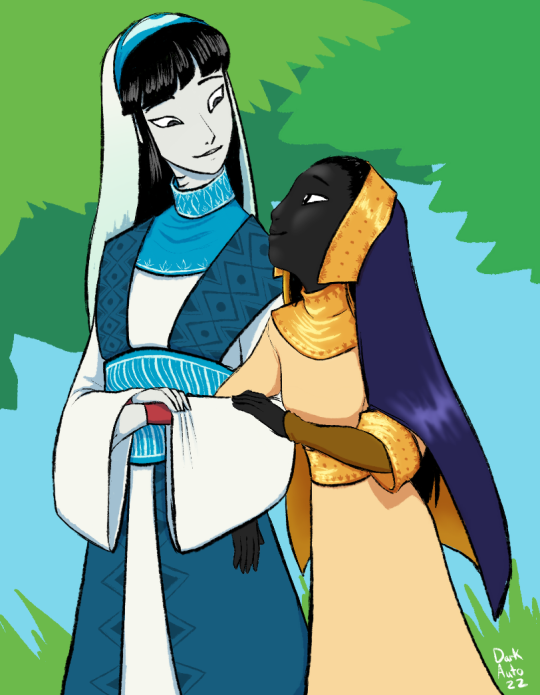
Fun Bits I Forgot to Organize
Tusks
Adult Basillans grow tusks like boars (based on the Godslayer's ascended model having these wicked tusks among his rows of fangs). They only really develop towards the latter portion of adolescence, around one's late teens to early 20s, and are regarded for the males as the sign that one has become a proper adult.


Of course, the downside is that these things are continuously growing and have to be trimmed every now and then in order to avoid poking oneself in the eye or scratching people with it.
The Vokara are especially finicky about covering their mouths for... not quite modesty reasons so much as baring one's scary teeth at another person is considered rude and aggressive. The Nanshen, living far more amphibiously and thus not really comfortable with more cloth than is comfortable underwater, don't care about that as much, though if you grimace at somebody they might kick you in the shins.
Barbels
A general rule I keep when designing out-of-water clothing for these guys is to cover the ears. In universe, it's because their barbels are very sensitive to differences in temperature and UV radiation out of the water, so it's deeply uncomfortable to have them uncovered for these guys. Out of universe, it's because The Hunter did something like this in her game, in addition to the ABZU people also covering most of their heads but not their chests for some reason (so probably not quite a modesty thing), and I decided to make up a silly specbio reason for it.
For some examples, here's a spread of different Nanshen city states and their different fashions:

History
The games are still canon here! But there's a little more to it.
The Nanshen had always been travellers, more keen to explore and establish their own territories far and wide. But after those dwelling in the Crown began messing with the Abzu, the life energy of the ocean itself, the ecosystem around the capitol collapsed and the population fled the area. Their former empire collapsed, and in its place, a number of different city states off the shore of their various old territories were established in its place.
Some time before, or maybe simultaneous to that, the Vokara had their own little collapse in the form of the Godslayer's rebellion. Many had read the writing on the wall and fled the Isle before he successfully slayed the gods and took control of the whole Island, leading to a number of villages and kingdoms being formed on the nearby continent, which would eventually spawn the Last Hunter, who would defeat the Godslayer.
There's more to it, but I think I'm approaching Tumblr's picture limit, and I've got more, sillier pictures from the AU. I'll add those later!
#metamorphoverse au#crossover hell#abzu#journey#sky children of the light#the pathless#long post#my art#headcanons#there's like three years of worldbuilding in this
19 notes
·
View notes
Text
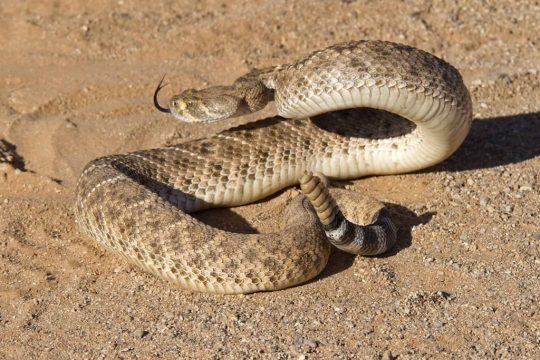

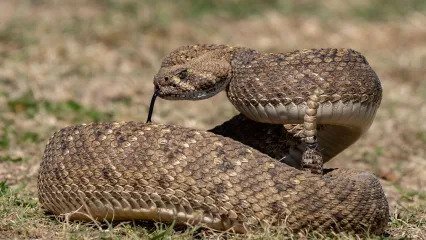

Wild Western Diamondback Rattlesnakes
Also known by the nicknames the Texas diamondback rattlesnake, the adobe snake, and the buzz tail, to name a few, the western diamondback rattlesnake (Crotalus atrox) is found throughout the southwestern United States and northern Mexico. This species is one of the iconic symbols of the region, and particularly of the deserts and scrublands in which it lives.
C. atrox has several features that distinguish it from its eastern relative. The western diamondback is slightly smaller, reaching a length of 1.5 m (4.9 ft) and a weight of 6.7 kg (14.7 lbs) at full maturity. They are also lighter in color, typically sporting tan, blueish gray, or pink scales with a darker diamond pattern along the body which gives the species its common name. Lastly, the face has white markings around the eyes and nostrils, and the tail below the rattle is white with black bands. Males and females appear similar; the most reliable way to tell the difference is by the tail. Male tails are thicker, longer, and taper gradually from the body, while female tails narrow abruptly at the base of the body.
The rattle itself is a unique feature of rattlesnakes. It is made of a series of hollow keratin chambers. When a rattlesnake is threatened, a set of muscles at the base of the tail constrict and cause the keratin chambers to vibrate against each other to produce a rattling sound. These muscles move incredibly fast, at about 50 times a second, and a rattle can be sustained for up to three hours-- not that most animals stick around that long. This rattle is present at birth as a tiny 'button', but juveniles are unable to rattle until their first molt, when a second segment is added. Rattlesnakes continue to add segments at each molt throughout their lives, but it's not uncommon for the top segments to become loose and fall off over time.
Mating for the western diamondback rattlesnake occurs in the fall and spring, from October to March. During the winter, individuals hibernate in abandoned burrows or under rocks, though some may emerge prematurely to seek out mates. Once they locate a female, males engage in an elaborate courtship ritual in which they chase the female, 'dance' in front of her, and fight other rival males. If the female is receptive, copulation can last for several hours. Following a successful mating encounter, females gestate for 167 days. Rattlesnakes are ovoviviparous, meaning that the female incubates her eggs inside her body and then gives birth to live young. After hatching, juveniles only stay with their mother a few hours before striking out on their own. Individuals reach maturity at three years old, and can live to be as old as 25.
Due to their venomous defence, C. atrox has few terrestrial predators. Their primary threats come from hawks, eagles, wild turkeys, and roadrunners, the latter of which have specifically evolved to hunt rattlesnakes. In contrast, the western diamondback rattlesnake has a broad appetite and hunts a variety of rodents, birds, and lizards. They are ambush predators, able to detect their prey through smell and heat. Rattlesnakes have a 'pit' on each side of their heads that contain a heat-sensing organ; this organ is so sensitive that an individual can detect prey only 1/10 of a degree warmer than its background.
Of the rattlesnake species, the western diamondback is considered one of the more aggressive, and is responsible for a majority of the snake bites in the United States. Its venom can be fatal to humans, partially due to the large amount of venom delivered in a single bite. However, C. atrox does not seek out human encounters, and only strikes when cornered. Antivenom for this species is available, and if administered soon after being bitten the recovery rate for victims is quite high.
Conservation status: The IUCN has designated the western diamondback rattlesnake as Least Concern. This species is heavily hunted throughout its range, both for its perceived threat to humans, and for its valuable meat and skin.
If you like what I do, consider leaving a tip or buying me a ko-fi!
Photos
Ned Harris and Wayne Klement
Wes Edens
Geoff Gallice
Derek Dykstra
#western diamondback rattlesnake#Squamata#Viperidae#rattlesnakes#vipers#Colubrid snakes#snakes#serpents#squamates#reptiles#deserts#desert reptiles#scrubland#scrubland reptiles#north america#southern north america#central america#animal facts#biology#zoology
136 notes
·
View notes